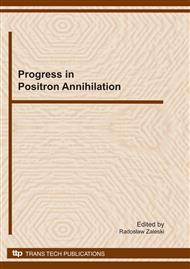p.81
p.85
p.89
p.93
p.99
p.103
p.109
p.115
p.119
Preliminary Positron Lifetime Results on Free Volumes in Cyclodextrins
Abstract:
Positron annihilation lifetime spectroscopy was used to study the free-volume parameters in various pure -, - and -cyclodextrins samples and, in the case of β-cyclodextrin, with inclusion of S-carvone and thymoquinone. The results clearly indicate the presence of long lifetime components related to Ps-formation. The data show that the addition of S-carvone to β-cyclodextrin results in a decrease of o-Ps lifetime that we ascribe to a reduction of free volume holes from 81.8 to 63.7 Å3. The long lifetime component disappears when thymoquinone is added to -cyclodextrin, indicating this substance acts as an o-Ps quencher. For all samples studied, a decrease in the long lifetime component values was observed with increasing source in situ time, a result that might be attributed to the irradiation of the sample by the 22Na positron source.
Info:
Periodical:
Pages:
99-102
Citation:
Online since:
December 2010
Keywords:
Price:
Сopyright:
© 2011 Trans Tech Publications Ltd. All Rights Reserved
Share:
Citation:


